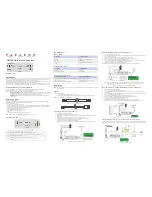
WAVECOM Decoder W74PC, W-PCI/e, W-CODE, W-CLOUD Manual V9.1.0
Transmission Modes
185
Parameter
Value
Receiver settings
FM BW = 40 kHz
Input format(s)
AF
Additional Info
IOC 288
The software is started in automatic mode by clicking on the
Auto
button or on
Drum speed
for manual
mode. In manual mode the correct display of the image is controlled using the
Phase
function in the
Op-
tions
menu.
The special items
AM-Gain
and
AM-Offset
are placed in the
Demodulator
menu. Centering of the signal
deviation on the bar graph is controlled by adjusting
AM-Offset
. In addition maximum deviation is re-
quired on the bar graph. This is done by adjusting
AM-Gain
. It should be noted that these two adjust-
ments are influenced by each other.
Meteosat reception requires a parabolic reflector and receiver. The AF output of the receiver may be fed
directly into the decoder, which converts it into a weather image viewing station providing excellent image
quality.
The decoder allows a continuous and smooth alignment of the image as it is being received from
Op-
tions/Fine Speed
. By using the
Phase
item in the
Options
menu the image can be shifted into the cor-
rect position.
Flip Left-Right
and
Flip Top-Down
will reverse the image or turn it upside down.
MFSK-20
MFSK-20 is a sequential 20 tone mode, which is optimized for the transmission of numeric codes. MFSK-
20 is similar to SP-14 and AUM-13.
Parameter
Value
Frequency range
HF
Operation modes
FSK, Broadcast/Simplex
Modulation
MFSK-20
Speed
100 ms, 50 ms
Receiver settings
DATA, CW, LSB or USB
Input format(s)
AF, IF
Most of the tones have been assigned a character:
10 tones are assigned to the numerals 0..9
One tone is used as an idle character
One tone is used as a space character
One tone is used as a repetition indicator
Six tones are assigned to characters
All other tones are undefined.
A transmission is initiated with a start sequence, which identifies this mode and may be used for accurate
tuning. This sequence is transmitted at 1 Baud, which makes it readable even during very unfavorable
conditions.
The data is transmitted at a rate of 10 or 20 Baud. A block synchronization sequence is initially transmit-
ted followed by the five digit code words. If more than one block is transmitted, a block synchronization
sequence is inserted between the different blocks. As the transmission rate is very low this mode is insen-
sitive to fading and multipath propagation.
















































